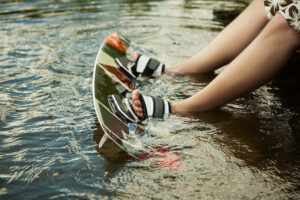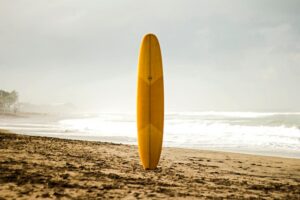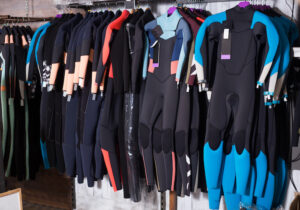Embark on an adrenaline-fueled journey as we delve into a thrilling world of kitesurfing on land. Also known as kite landboarding, this captivating sport takes the heart-pounding excitement of traditional kitesurfing and adds a unique twist—riding on diverse terrains.
From the essential gear to safety tips and breathtaking locations, this article explores fundamentals, some great locations for kite landboarding, and advanced techniques that surround this dynamic activity. Join us as we unravel the excitement, challenges, and sheer joy that land kitesurfing enthusiasts experience while harnessing the power of the wind on solid ground.
In this article, you will get answers to these questions:
- What is the difference between kitesurfing on land vs. on water?
- What are the best locations for kitesurfing on land?
- What are the basics of kite landboarding?
- Which gear is essential for landboarding?
- And what is the best kite for landboarding for me?
Basics of Kitesurfing on Land – A Introduction
At its core, kitesurfing on land combines the dynamics of traditional kitesurfing with freedom to explore various terrains. Enthusiasts utilize specially designed kites and boards, adapting their skills to navigate over beaches, grassy fields, or even desert dunes.
This article will delve into the basics of kite landboarding and look at differences between kitesurfing on land vs. on water. And since choosing the best kite for landboarding is a must, we will also provide insights into selecting the right kite, board, and safety equipment.
Aspiring land kiters will gain a comprehensive overview, setting the stage for a thrilling exploration of this unique fusion of wind power and terrestrial terrain.
Kitesurfing on Land vs. on Water
While some main principles of harnessing wind power remain consistent, a main distinction between kitesurfing on land and kitesurfing on water lies in the dynamic environments they traverse. On water, kitesurfers ride waves, performing tricks and maneuvers while being buoyed by the sea.
In contrast, when kitesurfing on land, you harness the wind’s force on solid ground, allowing for exploration across diverse landscapes. Terrain dictates experience; water kiting emphasizes fluidity and wave dynamics, while kitesurfing on land introduces the challenge of navigating varied surfaces.
Each variant offers a unique thrill, attracting individuals based on their preference for sea or land adventures. Take a look at the table below to get a good overview of the pros and cons to kitesurfing on land vs. on water.
| Aspect | Kitesurfing on Land | Kitesurfing on Water |
| PROS | ||
| Accessibility | Suitable for various terrains, accessible in more areas | Requires access to suitable water bodies |
| Learning Curve | Generally easier for beginners | Steeper learning curve, especially in choppy waters |
| Terrain Variety | Diverse landscapes like beaches, fields, and deserts | Dynamic water environments with waves and currents |
| Safety | Falls on solid ground may be less impactful | Water provides a softer landing, reducing impact |
| Cooling Effect | Lack of cooling effect from water | Enjoy the refreshing feeling of being in the water |
| Creativity | Platform for creative expression with tricks | Freestyle tricks, jumps, and wave riding opportunities |
| CONS | ||
| Weather Dependency | Sensitive to wind conditions, may require specific winds | Dependent on favorable weather, tides, and conditions |
| Equipment Maintenance | Land gear may experience wear on abrasive surfaces | Exposure to saltwater can impact equipment longevity |
| Location Limitations | Dependent on accessible open spaces for kitesurfing on land | Requires proximity to suitable bodies of water |
| Risk of Injury | Falls on solid ground may pose a risk of injury | Potential for collisions with water obstacles |
| Gear Transport | Easier transportation of land kiting equipment | Requires larger gear and transport for water equipment |
| Global Popularity | Growing popularity in diverse locations | More established and widespread global popularity |
What are the best places for kitesurfing on land?
Choosing an ideal terrain adds an extra layer of excitement to kite landboarding, and enthusiasts often explore multiple types of landscapes to diversify their riding adventures.
Here’s a list of the best terrains for kitesurfing on land:
1. Beaches: Sandy shores provide a classic and accessible terrain for kitesurfing on land, offering a smooth surface for riders to glide along coastlines.
2. Grassy Fields: Open fields with grassy surfaces offer a softer landing and are best for landboarding beginners practicing control and maneuvering with their kites.
3. Desert Dunes: When kitesurfing on land, some adventurers seek the thrilling desert, navigating through expansive sand dunes that provide a unique and challenging experience.
4. Snow-covered Landscapes: In colder regions, kitesurfing on land can be adapted for snow-covered landscapes, adding a winter sports element to this activity.
5. Parks and Open Spaces: Urban areas with parks or open spaces become playgrounds for kite landboarding enthusiasts, allowing for recreational riding in city surroundings.
While these are some more popular spots for kite landboarding, you might also get a thrill of kite landboarding in dry lake beds. They are usually flat and expansive and provide a vast and open terrain for advanced land kiters seeking high-speed runs and tricks.
Or have you ever thought about kitesurfing on a farm? These rural landscapes are definitely something you want to keep in mind if you are looking for those rather unconventional spots with a great touch of nature to them.
How to Kitesurf on Land for Beginners: The first Steps
Are you ready for take-off? Embarking on an exhilarating journey of kitesurfing begins with mastering the fundamentals.
In this chapter, we unravel essential steps to guide aspiring kitesurfers through the initial stages of this dynamic sport. From understanding your basic equipment to grasping crucial safety measures, we provide a comprehensive roadmap for beginners.
Discover the art of controlling your kite, harnessing the wind’s power, and eventually taking those first thrilling rides on land. Whether you’re standing on a sandy beach or a grassy field, these foundational steps pave the way for an exciting and rewarding kitesurfing adventure. Let’s start off by looking at the essential gear needed for kitesurfing on land.
Essential Gear for Kite Landboarding
Equipping yourself with proper gear is paramount to the exhilarating world of kite landboarding. Your essential ensemble includes a power kite, specially designed land kiteboard, safety gear, and a harness.
Power Kites
Power kites are the driving force behind the exhilarating experience of kitesurfing on land. Available in various designs, including foil and leading edge inflatable (LEI), these kites harness the wind’s power to propel riders across diverse terrains. Foil kites, lightweight and versatile, excel in lighter winds, providing easy control for beginners.
On the other hand, LEI kites offer stability and increased power, ideal for advanced maneuvers and stronger wind conditions. Mastering the art of controlling these kites is fundamental to kitesurfing on land, allowing riders to soar and perform thrilling tricks while connected to the dynamic force of the wind.
Land Kiteboard
A land kiteboard is a specialized piece of equipment designed to traverse a variety of terrains with ease. Unlike traditional water kiteboards, land kiteboards are equipped with large, rugged wheels, enabling riders to smoothly navigate over surfaces like beaches, grassy fields, or even snow-covered landscapes.
A landboard’s wheels are often inflatable, providing a degree of suspension for a more comfortable ride over uneven terrain. Its deck is robust and durable, built to withstand the rigors of kitesurfing on land. Riders can choose from different styles and shapes of land kiteboards based on their preferences and the specific conditions of the terrain they plan to explore.
Safety gear
Safety is paramount in kitesurfing on land, and the right safety gear is essential for protecting yourself while learning how to kitesurf and performing high-speed maneuvers. A helmet is a must to safeguard your head from potential impacts, and it should be properly fitted and securely fastened.
Protective pads for knees and elbows add an extra layer of defense, preventing injuries during falls or unexpected incidents. Wearing gloves can also be beneficial, providing grip on the kite control bar and protecting your hands from abrasions.
Additionally, a well-designed kite harness securely attaches you to your kite, distributing the force of the wind and allowing for better control. Investing in reliable safety gear ensures that you can enjoy the thrill of kite landboarding with confidence, knowing that you are well-protected in case of unforeseen circumstances.
Here is an indication of the prices for each piece of equipment:
| PIECE OF EQUIPMENT | PRICE RANGE |
| Power Kite | |
| · Entry-level foil kites | $100 – $300 |
| · Advanced foil or LEI kites | $500 – $1,500+ |
| Land Kiteboard | |
| · Basic land kiteboards: | $150 – $400 |
| · High-performance or specialized land kiteboards | $400 – $1,000+ |
| Control Bar and Lines | |
| · Basic control bars | $100 – $300 |
| · High-performance control bars | $300 – $600+ |
| Safety Gear | |
| · Helmet | $50 – $150 |
| · Knee and elbow pads | $30 – $100 |
| · Harness | $100 – $300 |
| · Gloves | $20 – $50 |
| Accessories | |
| · Pump (for LEI kites) | $20 – $50 |
| · Repair kits | $10 – $30 |
| · Kite bag | $30 – $100 |
Understanding the nuances of each component and choosing gear that aligns with your skill level and intended terrain is crucial. As you start off your kite landboarding journey, investing in reliable, high-quality gear not only enhances your safety but also elevates the overall experience, allowing you to confidently ride the wind on solid ground.
Safety Measures before starting your Kite Landboarding Journey
Kite landboarding, while exhilarating, demands a strict adherence to safety measures to ensure a thrilling yet secure experience. The foremost precaution involves selecting an appropriate kite size for your skill level and prevailing wind conditions.
Beginners should start with smaller kites to maintain better control and mitigate the risk of overpowering gusts. Rigorous and regular checks of all equipment, including your kite lines, harness, and board, are crucial to identify potential wear or damage.
Tip: for ensuring safety in kite landboarding is to always have a designated “safety buddy” or spotter, especially when riding in more remote or challenging terrains. This person serves as an extra set of eyes, alert to potential hazards, changing wind conditions, or any unforeseen challenges that might arise during your session.
Additionally, wearing a well-fitted helmet is non-negotiable, safeguarding against head injuries in case of falls or collisions. Protective pads for knees and elbows offer crucial cushioning during tumbles, minimizing your risk of abrasions and bruises. Gloves provide a firm grip on the control bar and shield hands from friction.
Riders should also be well-versed in emergency release procedures, enabling them to quickly detach from the kite in unexpected circumstances.
Being weather-aware is paramount; monitoring wind conditions and forecasts ensures that you embark on your kite landboarding adventure under optimal and safe circumstances.
Finally, continuous learning, perhaps through lessons from experienced instructors, enhances your skills and understanding of safety protocols, fostering a culture of responsible and secure kite landboarding.
By prioritizing these safety measures, you will fully embrace the thrill of kitesurfing on land while minimizing potential risks and ensuring a fulfilling experience.
Getting Started: A Step-by-Step Guide
Now that you have the essential gear and know all important safety measures, it is time to get started. For a successful first-time kite landboarding experience, follow these step-by-step guidelines to confidently navigate your thrilling adventure.
Start by selecting an open and obstacle-free space with consistent winds, ideally between 10 and 20 knots, and minimal gusts. Then, lay out your land kiteboard on a flat surface, ensuring it is clear of any debris.
Perform a meticulous equipment check, inspecting your kite lines, harness, and board for any signs of wear or damage. With your safety gear securely fastened, start by laying out your power kite on the ground, leading edge facing into the wind.
Next, secure the kite lines to your harness, ensuring they are untangled and free from knots. Signal a trusted assistant or safety buddy to help launch the kite. As your kite catches the wind, maintain a firm grip on the control bar and gradually steer your kite upward. Focus on developing a sense of control by practicing small turns and mastering the kite’s position within the wind window.
When comfortable, begin incorporating slight pulls on the control bar to experience the power generated by the kite. Keep your body weight centered over your board, and, as you gain confidence, introduce controlled movements to guide your board in different directions.
Mastering the basics of controlling the kite is crucial before attempting to ride the board. Once you feel confident in managing the kite, gradually introduce movement on the board by applying gentle pressure with your feet.
Focus on maintaining balance and coordination, allowing your board to glide smoothly over any chosen terrain. Practice controlling the speed and direction of your kite while keeping a steady stance on the board.
The Step-by-Step of kite landboarding for Beginners at a glance:
1. Check and Prepare Equipment
2. Safety First
3. Launch the Kite
4. Master Kite Control
5. Board Introduction
6. Gradual Board Riding
7. Progressive Skill Building
8. Continuous Safety Awareness
9. Enjoy the Experience
For your first few sessions, focus on these fundamental skills, progressively building your proficiency and comfort level. Remember to continuously assess wind conditions, prioritize safety, and enjoy the exhilaration of your first steps into the exciting world of kite landboarding.
Improving Your Skills
Once you feel comfortable with the basics of kitesurfing on land, you will probably quickly seek to elevate your skills, mastering a repertoire of thrilling techniques and tricks that push the boundaries of this sport.
Power Slides
One such advanced technique is power slides, where riders skillfully manipulate the kite and board to execute controlled slides on various terrains, showcasing precision and finesse.
Grabs
Jumping variations, such as grabs and rotations, add an aerial dimension to kite landboarding, requiring precise coordination between kite control and body movements.
Kiteloops
For those craving an extra challenge, executing kiteloops involves steering the kite in a circular motion, generating powerful pulls and dynamic movements.
Riding Switch
As you progress, mastering the art of riding switch will add versatility to your skill set. Riding switch means riding with the opposite foot forward. It will be tough and feel off at first – just like writing with your other hand – but will take your skills to the next level.
Freestyle land kiters also experiment with ground tricks, including spins, flips, and board-offs, pushing the boundaries of creativity and self-expression. So, keep on practicing, and you will quickly see how versatile the world of kite landboarding can be.
Now that you know everything about kitesurfing on land, you are ready to go. And in case you plan to get wet first and learn more about surfing in the water, you can check out some of the world’s best surf spots here.
FAQ–Most Asked Questions of Kitesurfing on Land
Where can I legally kitesurf on land?
Legal locations for kitesurfing on land vary depending on local regulations and land access policies. So, it is critical that you get informed about the specific regulations before you head out.
However, some countries have designated areas or parks specifically catering to kite-related activities. You can find many of these in the United States, the UK, The Netherlands, New Zealand, or Australia.
Is kite landboarding more challenging than water kitesurfing?
Kite landboarding is often considered more accessible for beginners due to the flatter learning curve, especially on open spaces like beaches or grassy fields. The absence of water can make falls on solid ground less impactful, contributing to a more forgiving environment for novice riders.
On the other hand, water kitesurfing presents additional challenges such as mastering wave dynamics, water starts, and managing the board in various conditions.
What are Common Mistakes Beginners make in Kite Landboarding?
One prevalent error is insufficient attention to wind conditions. Beginners may overlook the significance of understanding wind direction and speed, leading to difficulties in kite control.
Overestimating one’s abilities is another common pitfall; attempting advanced maneuvers without mastering basic kite control can result in loss of control and falls.
Poor body positioning is yet another mistake, as beginners may neglect maintaining a balanced stance, affecting their ability to control both the kite and the board effectively. Failing to respect safety guidelines and neglecting proper safety gear can also pose risks.
Lastly, impatience is a frequent error—kitesurfing on land takes time to learn, and rushing through the foundational stages can hinder progress. So, take your time and enjoy the process and who knows, maybe you will become the next kite landboarding champion.
What is the best kite for landboarding?
Selecting the best kite for landboarding of course varies based on individual preferences, skill level, and the specific conditions of the riding location. Nonetheless, there are some important factors you should look out for when buying your kite.
Generally, a depowerable kite, specifically a foil kite or a leading edge inflatable (LEI) kite, is well-suited for landboarding. Foil kites are lightweight and offer simplicity in design, making them suitable for beginners. They excel in lighter winds and are easy to relaunch if they touch the ground. On the other hand, LEI kites provide increased stability and power, making them ideal for those already advanced in kite landboarding who want to perform tricks and maneuvers.
It’s crucial to choose a kite with a size appropriate for your weight and the prevailing wind conditions in the chosen landboarding terrain. Additionally, modern kites often come with safety features like quick-release systems, enhancing overall control and ensuring a safer experience when kitesurfing on land.









